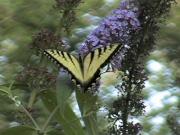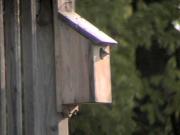by Julie Zickefoose
1. Put up snags. An open,
featureless lawn has lots of good foraging for bluebirds in the form
of cutworms, caterpillars, spiders, and beetle larvae, but they may
not be able to find them. Bluebirds are hunters; they sit on a
perch, scan the ground, and drop to capture their prey. To do this
they need lots of perches. Garden posts, powerlines, and clothesline
poles help, but you can greatly increase the attractiveness of your
yard by supplying other perches. Nicely sculpted fallen trees and
branches litter any forest floor and can be had for free, or if
you're into Bauhaus, you can nail up a T-stand that will be just as
gladly accepted. Scatter these across your lawn or meadow, and
you've created foraging perches that will enable bluebirds to use
your backyard habitat to its fullest extent.
2. Add water. Like all
thrushes, bluebirds love to bathe, and they'll make a daily habit of
it if your birdbath is kept clean and filled. Make sure it's
shallow--no more than two inches deep--and out in the open, away
from shrubbery that could conceal lurking cats. A perch placed
nearby, but not hanging over, the bath will make it more attractive
to bluebirds.
3. Plant for fruit. In the
fall, bluebirds shift their diet largely to fruit. A few of their
favorites are dogwood, viburnums, American bittersweet, American
honeysuckle, and the humble pokeweed. Stick to native plants that
are hardy for your region.
4. Keep it mowed. Bluebirds
find their best foraging in shorter grasses. If your boxes are in
meadows that grow more than calf high during the summer, bluebirds
might nest there early in the season, then desert them for
shorter-grass areas where they can more easily find food. We mow
large patches in the meadow near our bluebird boxes (see "The Better
Bluebird Box" for bluebird-box plans and information). We put up
snags or T-stands and are gratified to see the bluebirds using these
areas within minutes.
5. Offer extra protein.
Bluebirds love mealworms and quickly learn to come to your call when
you offer them. More than just tasty treats, mealworms can help
bluebirds and their broods through periods of prolonged rain, cold,
or drought when insects are hard to find. For such emergency
intervention, place a handful of mealworms in a shallow dish atop or
just beside the box. It won't take the adults long to find them and
connect the offering with your presence.
|






 Woodside Gardens
The Registry of Nature Habitats
Woodside Gardens
The Registry of Nature Habitats 
 1999 -
1999 -

![[Mourning Dove]](http://www.abirdshome.com/images/mdove1.jpg)
![[Rose Breasted Grosbeak]](http://www.abirdshome.com/images/grosbeak1.jpg)
![[White Breasted Nuthatch]](http://www.abirdshome.com/images/nuthatch1.jpg)
![[Cowbird]](http://www.abirdshome.com/images/cowbird.jpg)
![[Heron]](http://www.abirdshome.com/images/heron.jpg)
![[Water Attracts Wildlife]](http://www.abirdshome.com/images/yard1.jpg)

![[Downy Woodpecker]](http://www.abirdshome.com/images/dwoodpecker1.jpg)
![[Black Capped Chickadee]](http://www.abirdshome.com/images/chickadee1.jpg)
![[Wood Duck]](http://www.abirdshome.com/images/woodduck.jpg)
![[Ponds Attract Wildlife]](http://www.abirdshome.com/images/pond1.jpg)
![[Moths]](http://www.abirdshome.com/images/moth1.jpg)
